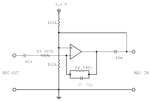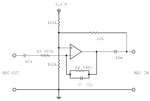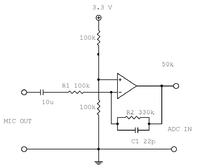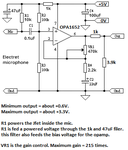electroman2000
Member level 2
Hi everyone,
I'm developing a system that store the voice recorded by a microphone into a SD card trough a microcontroller. I would ask a question about the conditioning circuit for the microphone. I set the voltage reference of microcontroller's ADC at 3.3 V and 0 V for high and low voltage reference respectively. The microhpone is a preamplified condenser microphone; in the datasheet is reported that the max output voltage is 0.355 V rms.
I want design a conditioning circuit that can match perfectly microhpone output with ADC's microcontroller input and, of course, translate all negative voltages in positive voltages. I made the following calculation, tell me if I'm wrong:
I first calculated the max output voltage: 0.355*sqrt(2) = 0.5 V. Then I suppose a max positive voltage of 0.5 V and a max negative voltage of -0.5 V (I'm not sure of this). To have only a positive voltage in ADC input, I must design a "mute voltage" of 3.3/2=1.65 V. Then, the max variation I can have without damage the ADC and using all range is 1.65. So I calculated the max gain, that is 1.65/0.5= 3.3. I attach the circuit that I have made: a low pass filter with a single supply voltage. The two 100K resistor split the voltage for the single supply AND provide the "mute voltage" at the input of ADC. The R2=330kohm and C2=22pF provide a cutoff frequency of about 22 kHz. R1=100khom provide a gain of 330k/100k=3.3.
Will I reach the max matching between microphone and ADC with this circuit?
Thank you everyone and sorry for my english.
I'm developing a system that store the voice recorded by a microphone into a SD card trough a microcontroller. I would ask a question about the conditioning circuit for the microphone. I set the voltage reference of microcontroller's ADC at 3.3 V and 0 V for high and low voltage reference respectively. The microhpone is a preamplified condenser microphone; in the datasheet is reported that the max output voltage is 0.355 V rms.
I want design a conditioning circuit that can match perfectly microhpone output with ADC's microcontroller input and, of course, translate all negative voltages in positive voltages. I made the following calculation, tell me if I'm wrong:
I first calculated the max output voltage: 0.355*sqrt(2) = 0.5 V. Then I suppose a max positive voltage of 0.5 V and a max negative voltage of -0.5 V (I'm not sure of this). To have only a positive voltage in ADC input, I must design a "mute voltage" of 3.3/2=1.65 V. Then, the max variation I can have without damage the ADC and using all range is 1.65. So I calculated the max gain, that is 1.65/0.5= 3.3. I attach the circuit that I have made: a low pass filter with a single supply voltage. The two 100K resistor split the voltage for the single supply AND provide the "mute voltage" at the input of ADC. The R2=330kohm and C2=22pF provide a cutoff frequency of about 22 kHz. R1=100khom provide a gain of 330k/100k=3.3.
Will I reach the max matching between microphone and ADC with this circuit?
Thank you everyone and sorry for my english.



